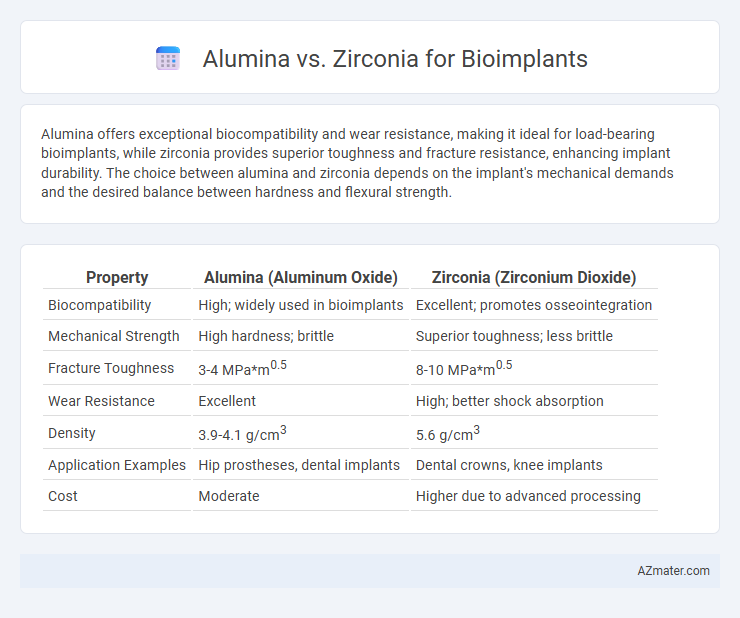Alumina offers exceptional biocompatibility and wear resistance, making it ideal for load-bearing bioimplants, while zirconia provides superior toughness and fracture resistance, enhancing implant durability. The choice between alumina and zirconia depends on the implant's mechanical demands and the desired balance between hardness and flexural strength.
Table of Comparison
| Property | Alumina (Aluminum Oxide) | Zirconia (Zirconium Dioxide) |
|---|---|---|
| Biocompatibility | High; widely used in bioimplants | Excellent; promotes osseointegration |
| Mechanical Strength | High hardness; brittle | Superior toughness; less brittle |
| Fracture Toughness | 3-4 MPa*m0.5 | 8-10 MPa*m0.5 |
| Wear Resistance | Excellent | High; better shock absorption |
| Density | 3.9-4.1 g/cm3 | 5.6 g/cm3 |
| Application Examples | Hip prostheses, dental implants | Dental crowns, knee implants |
| Cost | Moderate | Higher due to advanced processing |
Introduction to Bioimplant Materials
Alumina and zirconia are two leading ceramic materials used in bioimplant applications due to their exceptional biocompatibility and mechanical properties. Alumina offers high hardness and wear resistance, making it suitable for load-bearing implants such as hip prostheses, while zirconia provides superior fracture toughness and corrosion resistance, enhancing implant longevity. The selection between alumina and zirconia depends on specific implant requirements, balancing factors like strength, durability, and biological interaction for optimal patient outcomes.
Understanding Alumina: Properties and Applications
Alumina exhibits exceptional hardness, biocompatibility, and wear resistance, making it a prime material for bioimplants such as hip and dental prostheses. Its high fracture toughness and chemical stability ensure long-term durability within the human body while minimizing inflammatory responses. These properties enable alumina to maintain structural integrity and functionality in load-bearing applications, outperforming many ceramics in biomedical engineering.
Zirconia: Key Characteristics and Uses in Bioimplants
Zirconia exhibits exceptional biocompatibility, high fracture toughness, and excellent wear resistance, making it a preferred material for bioimplants over alumina. Its ability to withstand mechanical stress and resist corrosion in the human body enables its widespread application in dental implants, hip replacements, and orthopedic devices. The material's white color and aesthetic appeal also contribute to its use in visible implants, enhancing patient satisfaction and clinical outcomes.
Mechanical Strength: Alumina vs Zirconia
Zirconia exhibits superior mechanical strength compared to alumina, with fracture toughness values ranging from 5 to 10 MPa*m^0.5, whereas alumina typically ranges around 3 to 4 MPa*m^0.5. The higher flexural strength of zirconia, often exceeding 900 MPa, enhances its resistance to crack propagation under load, making it more suitable for load-bearing bioimplant applications. Alumina, while possessing excellent hardness and wear resistance, is more brittle and prone to catastrophic failure under high stress conditions.
Biocompatibility Comparison
Alumina exhibits excellent biocompatibility with low cytotoxicity and minimal inflammatory response, making it a reliable material for bioimplants. Zirconia demonstrates superior osseointegration properties and higher fracture toughness, offering enhanced durability and stability in load-bearing applications. Research indicates that zirconia's bioinert surface promotes better tissue compatibility, while alumina maintains long-term chemical stability in the physiological environment.
Wear Resistance and Longevity
Alumina and zirconia are widely used ceramic materials in bioimplants, with alumina known for its exceptional wear resistance and biocompatibility, making it a reliable option for long-term use. Zirconia offers superior toughness and fracture resistance, leading to increased longevity in load-bearing implants, while maintaining good wear resistance. Both materials contribute significantly to implant durability, but zirconia's enhanced mechanical properties often provide better performance in demanding biomedical applications.
Fracture Toughness and Reliability
Zirconia exhibits superior fracture toughness compared to alumina, typically with values around 9-10 MPa*m^0.5 for zirconia versus 3-4 MPa*m^0.5 for alumina, making it more resistant to crack propagation in bioimplant applications. The enhanced toughness of zirconia translates to greater reliability under physiological loading conditions, reducing the risk of implant failure. While alumina offers excellent hardness and wear resistance, zirconia's combination of toughness and biocompatibility generally provides higher long-term performance in fracture-critical bioimplants.
Corrosion Resistance in Biological Environments
Alumina and zirconia are widely utilized in bioimplants due to their superior corrosion resistance in biological environments. Alumina exhibits excellent chemical inertness and stability, resisting degradation in bodily fluids, which ensures long-term implant durability. Zirconia offers enhanced toughness and maintains corrosion resistance by forming a stable oxide layer that protects against ionic interaction with body tissues, minimizing the risk of implant failure.
Clinical Performance: Case Studies and Outcomes
Clinical studies reveal that alumina bioimplants exhibit excellent wear resistance and biocompatibility, with long-term success rates exceeding 90% in orthopedic applications. Zirconia implants demonstrate superior fracture toughness and improved osseointegration, often resulting in faster recovery times and lower failure rates in dental and load-bearing implants. Comparative outcomes indicate that zirconia's transformational toughening enhances clinical durability, while alumina remains favored for applications requiring higher wear resistance and chemical stability.
Future Trends in Ceramic Bioimplants
Future trends in ceramic bioimplants highlight the increasing adoption of zirconia due to its superior fracture toughness and wear resistance compared to alumina. Advances in nanostructuring and surface modification techniques aim to enhance the osseointegration and biocompatibility of both alumina and zirconia implants. Emerging research focuses on hybrid ceramic composites that combine alumina's high hardness with zirconia's toughness to optimize longevity and performance in orthopedic and dental applications.

Infographic: Alumina vs Zirconia for Bioimplant
 azmater.com
azmater.com